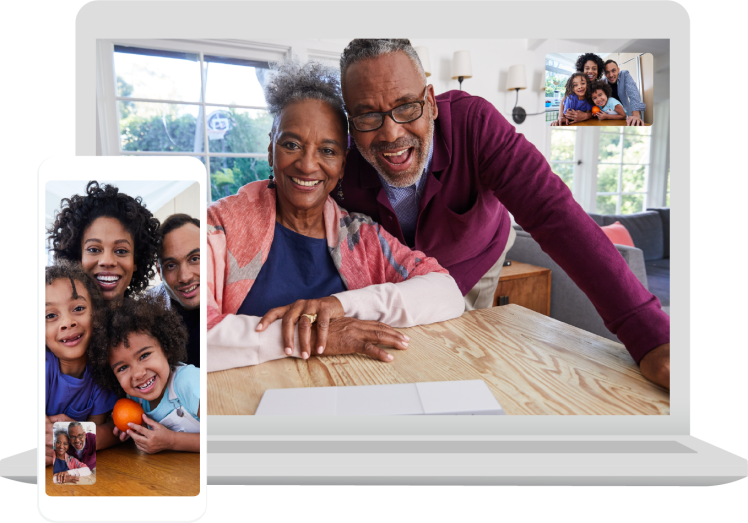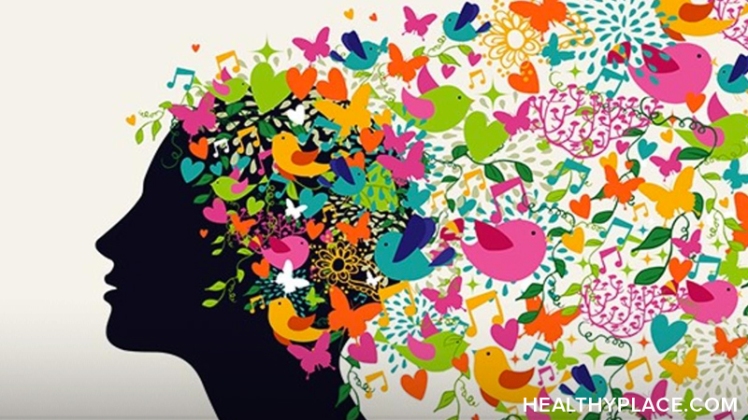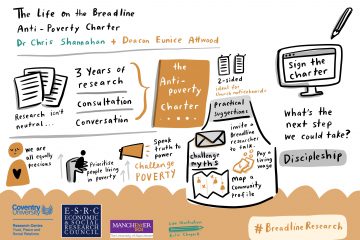This blog post is written by Paul Wright, a Street Connector Mentor in Birmingham. He originally wrote this on the Street Connectors blog, and has kindly agreed for us to re-post it for Life on the Breadline. Paul writes:
Tuesday 17th March is going to live long in my memory, when the Covid-19 global pandemic suddenly felt very real. Up until that point it was a thing we were being mindful about. For example, at church we washed hands as soon as we arrived, sharing the peace didn’t include the usual hand-shake and hug but was a creative use of sign language to say ‘peace be with you’. We changed our way of doing communion (not sharing one cup!) and refreshments after the service didn’t happen. All very strange, but we still gathered and experienced community in a way familiar to us. We hung out in the same building and spoke face-to-face. It felt like an act of solidarity and creativity. ‘Self-isolating’ and ‘social distancing’ were talked about and suggestions began to emerge of how to encourage a neighbourly response, but the implications of how this would challenge the very DNA of how we act in our community, our society and our world hadn’t fully come to light yet.
Monday evening [16th March] this changed as our Prime Minister announced that all ‘non-essential’ social gatherings should end, although it would be 5 days until he instructed pubs, restaurants, and leisure centres to close! Therefore, the decision was left with us about how to respond. The immediate practical response was, with a heavy heart, to close our community hub for social gatherings, and postpone all other organised social gatherings. We felt the call to social distancing was something to take very seriously, and we had to be an example to our neighbours that it couldn’t be ‘business as usual’. There was some fear, concern and anger at this decision; how could we step away at this moment of crisis? How can we close our doors when people will need each other more than ever before!? This was a response filled with raw emotion and very rational fears/questions. This was already a challenge to the very heart of our lives, the bonds we have built, and the ways we act in the love of our neighbour. How can we stay apart, but become closer together? How do we step back whilst also stepping up?

It can’t be ‘business as usual’
We are community builders. We creatively find ways to encourage social gathering, reduce social distancing, and encourage people to de-isolate into community. We would say all social gathering is ‘essential’, and the way we encourage this 99% of the time is what politicians would call ‘pressing the flesh’. Encouraging physical contact, shaking hands, hugs, knocking doors to have face-to-face conversation, hosting places of welcome, encouraging people to come out of their houses and gather socially. On Tuesday 17th March this way was having to be postponed, and we would need to work out how to ‘act’ in what felt like a new (and hopefully temporary) world. On Tuesday the usual agenda for our connectors meeting was put on hold, and we turned our attention to these questions (ones which we will be pondering for months to come):
How does physical distancing not mean goodbye, farewell, and separation, but promote news ways of presence, closeness, lovingness, and nearness?
How does social isolation not mean loneliness, segregation, and seclusion, but would require new ways of thinking through radical inclusion, solidarity, and mutual support?
How does the physical act of community building still happen? What does it mean to hunt the edges, increase the circles, encourage people to ‘show up’ and nurture a ‘community life’? Especially when this feels more vital to our wellbeing than ever before.
How do we ensure we don’t lean into a ‘needs based’ approach to an unfolding crisis and as it becomes more real? Categories of ‘vulnerable people’ are being circulated and focused upon. As people are being told they are vulnerable and at risk by the government, how are we continuing to seek what’s strong in our communities, not with what’s wrong? How do we encourage those who are crisis planning to ask the same questions, and how would collaboration make these strengths stronger still?
What does a neighbourly response look like? How can our many gifts, skills and talents be channelled into new creative and exciting ways? How do we continue to unearth the gifts of our neighbours, and encourage new ways these can be shared with each other?
There is much that will increasingly need doing ‘to’ or ‘for’ us (e.g. increasing pressure on the health service), but there will be increasing ways many will be asking what can we do ‘with’ our neighbours and what can be led ‘by’ neighbours, community organised and delivered with gentle humble back-up from those offering to support.

We have begun to practically respond to these questions, but we are aware things are changing on a day to day basis, it is very early days, and this response will grow and develop. Here’s some of the ways we have found useful so far:
Encouraging a neighbourly response
One of the things that emerged very quickly through social media was the now global #ViralKindness movement, which included a template for a flyer that neighbours could put through the door of their immediate neighbours. This has inspired self-organising in many neighbourhoods across the world, including ours.

We created a slightly amended version:


On the flyer alongside the offer of help we wanted there to be an invite to join in and get involved. For us this action, as hopefully all we do, is about encouraging mutual neighbourly relationships of trust, friendship and support, not just about mobilising an army of people offering to serve their neighbours.
It was the risk factors that we pondered on the most. We are trying to resist any form of control and we want to encourage and equip neighbours to support each other through this. At this time more than ever we felt we needed to not get in the way of neighbour to neighbour interaction. But we also felt there were some risks to think about. We didn’t want people to find themselves overwhelmed and overstretched. Each other’s wellbeing is more important than ever, and a reduction in physical interaction is required. We have suggested people begin with giving out 20 and see how this goes. We also felt this would nurture micro street level connections, which could last way beyond the next few months. It also means we don’t just lean on the people we already know that are involved in community building. Hopefully this will unearth as many people as possible willing to get involved.
We felt it was important to not ignore the very tough concern of those who may wish to take advantage or abuse this activity. Fundamentally we trust our neighbours, but there will be people, for a range of reasons, who might take advantage. To minimalise this we started encouraging people through our existing networks and relationships, which does spread relatively widely. Our next step is sharing this more widely through social media. We are collecting basic information from people who come forward alongside giving our number out asking people to ring if something doesn’t feel right. We feel this puts some safeguards in place, without discouraging and inhibiting neighbourliness and the radical offerings of care and kindness we hope that will emerge.
There are also many ways in which our neighbours are self-organising, looking out for each other, and continuing to be good neighbours. We are thanking them, saluting their efforts, and cheering them on in whatever way we can.
Stayin’ connected
For now, we can still use ‘old school’ ways of being connected like knocking on the door of a neighbour and speaking from a distance of two metres away. Plus, picking up the phone and giving someone a ring. I was reminded of the old Bob Hoskins ‘It’s good to talk’ adverts from the 1990’s. A message more relevant than ever.

In the past few years we have witnessed the explosion of platforms like WhatsApp, private Facebook groups & messenger, Twitter, Instagram & e-mail. Video options like FaceTime, WhatsApp video calling, Zoom, and Google Hangout. In our community building we’ve been using many of these as a secondary tool, but now they feel like they will become a much more central way we will stay in touch. Teaching my mom to use WhatsApp video call was hard work, but the look on her face when it worked was awesome. It’s obviously not going to replace the physical contact, but it will help.

The major challenge is how do we this for those who haven’t the resources to have wifi/data/tablet/laptop/smart phone or the desire/skills to become tech savvy. Apart from seeking ways to not rely on technology we haven’t any solutions yet. Would love to hear if any neighbourhoods have found ways to be generous with technology.
Getting creative & being open to new offerings

We’ve been blown away by how the many gifts, skills and talents of our neighbours have been offered in creative and exciting ways. We are seeing teachers and children’s workers creating online resources: www.stwilfridscommunitycentre.co.uk/community-arts, Facebook Group: Keep calm and carry on learning, sharing education resources they recommend, and offering their time to remotely support adults now home schooling. A mindfulness share group is moving to a Facebook Group offering meditations and tips for relaxation. We have people offering their time and cars to drive to pick up prescriptions, do foodbank runs, and go shopping. We have people offering to deliver seeds, tools, and resources required to start growing their own food, and ideas for food that grows in less than 2 months. Some of these are a re-imagining of things already present, some are new ways people are sharing themselves.

One of the most thoughtful and generous responses has been from local businesses. Some local shops started to ration key items way before the major supermarkets. They are offering to call customers to see how they are, offering free home deliveries for those self-isolating, and trying to get hold of items people are struggling to find (nappies, baby formula). A local take-away is offering a free meal to over 65’s. Apart from one outrageous example of overcharging (which made regional news outlets and provoked over 3000 Facebook shares within hours) they are all keeping prices to usual levels. For years we have been pondering a ‘shop local’ campaign but there didn’t seem to be the appetite for it. This crisis has driven people to look a little closer for their supplies, and encouraged local business owners to be creative and resourceful. This might spark a revolution in our local economy and changes to our shopping habits. That’s my hope, but I know people at the very least will not forget what their local businesses did.
I feel the creativity, resourcefulness, and imagination of our neighbours will be one of the most significant legacies (if that’s the right term with a pandemic!) of this turbulent time.

A possible enduring New World Order
Who knows how long this pandemic will last and how long the restrictions on physical interaction will be in place. There is talk of up to 12 months, and even longer for a possible vaccine. But the impact on our healthcare system, our structures of society, our mental health and wellbeing, and the marketplace as we know it will be felt for substantially longer. The question we can’t help but ponder even at this very early stage is what will be the long-term impact on our communities. Our friend Cormac Russell shared:
Perhaps, as the world self-organises community by community, and the marketplace goes quiet for a few months, we can work together to amplify a more hopeful and sustainable story for us and our planet: the better story of the rise of abundant communities across the globe that walk lightly on the earth. Perhaps then the question is not just how do we survive this pandemic, but also how do we sustain the #viralkindness and community building movements that this pandemic is precipitating?
At present we are in the thick of responding to what is near and now, but the questions Cormac offers are ones to turn our attention to and find ways to widen that discussion. Come share this journey with us and join the discussion.
Acknowledgements
I have wonderful colleagues here who are wresting and journey with this. These include Al Barrett (Twitter @hodgehillvicar), Tim Evans (@TimEvans1503), and local partner organisations who work on #TogetherWeCan community building activity (@HHOpenDoor @Worth_EBNS @FirsBromford), and our neighbours here in Firs and Bromford. We will continue to share our journey together.
A huge thank you to Cormac Russell for sharing much wisdom, encouragement and insight (Twitter @CormacRussell @NurtureDev). He is seeking ways to draw together wisdom from around the world and finding ways to share this widely.
Thanks to Vickie Cammack and Al Etmanski who’s article in the Globe and Mail a respected Canadian broadsheet newspaper, in-an-era-of-isolation-its-essential-we-maintain-social-connections provided much valued wisdom and encouragement, and a simple yet powerful 5 point framework for helping us think about how we can all maintain social connections in an era of isolation.
Paul Wright (@LeanLeft_Wright)
Street Connector Mentor 23/03/2020



1 Comment
Coronavirus: Missional and Theological reflections – Churches Together in England · 3rd August 2021 at 4:50 pm
[…] excellent blog on being neighbourly during coronavirus from The Life Beyond the Breadline Research Team at Coventry University. Also a helpful page […]
Comments are closed.